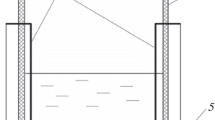Abstract
The thermally stimulated depolarized current and temperature profiles (TSDC analysis) on iced water was proved to be an effective tool for the qualitative evaluation of various water samples, each having an independent relaxation process, brought about by a pure dipolar orientation. The method proved to be applicable to different kinds of water samples used in the experiment and tap-water samples from different suppliers. Five main peaks (A to E, in the order of increasing temperature) were observed, of which two peaks (B and D) were found for the first time. The appearance of multiple peaks suggested the existence of multi-states of the hydrogen bond, cleaved by the TSDC process. The TSDC profiles were quite reproducible when the water samples contained practically no cations. A separate addition of each cation at a low concentration level revealed that a cation with a smaller ionic radius shifted peak A to a higher temperature. For ice of tap water, which contained relatively higher amount of cations, the TSDC profiles were quite different in shape compared with the standard ice-water samples (shift of peaks A–D to higher temperature, and a strong increase in the current strength of peaks B–E). However, it was still possible to tell from which districts the water samples were supplied.
Similar content being viewed by others
References
C. Bucci and R. Fieschi, Phys. Rev. Lett., 1964, 12, 16.
C. Bucci, R. Fieschi, and G. Guidi, Phys. Rev., 1966, 148, 816.
J. van Turnhout, “Topics in Applied Physics”, ed. G. M. Sessler, 1977, Vol. 33, Electrets, Springer, Berlin.
P. Pissis, D. Diamonti, and G. Boudouris, J. Phys., 1983, D16, 1311.
L. Onsager, D. L. Staebler, and S. Mascarenhas, J. Chem. Phys., 1978, 68(8), 3823.
A. Jeneveau and P. Sixou, Solid State Communications, 1972, 10, 191.
P. Pissis, G. Boudouris, J. L. Leveque, and J. C. Garson, Biopolymers, 1981, 20, 2649.
P. Pissis, G. Boudouris, J. C. Garson, and J. L. Leveque, Z. Naturforsh., 1981, 36a, 321.
P. Pissis, A. Anagnostopoulou-Konsta, L. Apekis, D. Daoukaki-Diamanti, and C. Christodoulides, J. non-Crystalline Solids, 1991, 95, 131.
L. Apekis and P. Pissis, J. DE PHYSIQUE, 1987, 48, C1.
A. H. Booth, Can. J. Chem., 1954, 32, 214.
Author information
Authors and Affiliations
Corresponding author
Rights and permissions
About this article
Cite this article
Sato, K., Koizumi, T. & Okajima, K. Analysis of Ice Water by the Thermally Stimulated Depolarized Current (TSDC) Method. ANAL. SCI. 21, 331–335 (2005). https://doi.org/10.2116/analsci.21.331
Received:
Accepted:
Published:
Issue Date:
DOI: https://doi.org/10.2116/analsci.21.331




